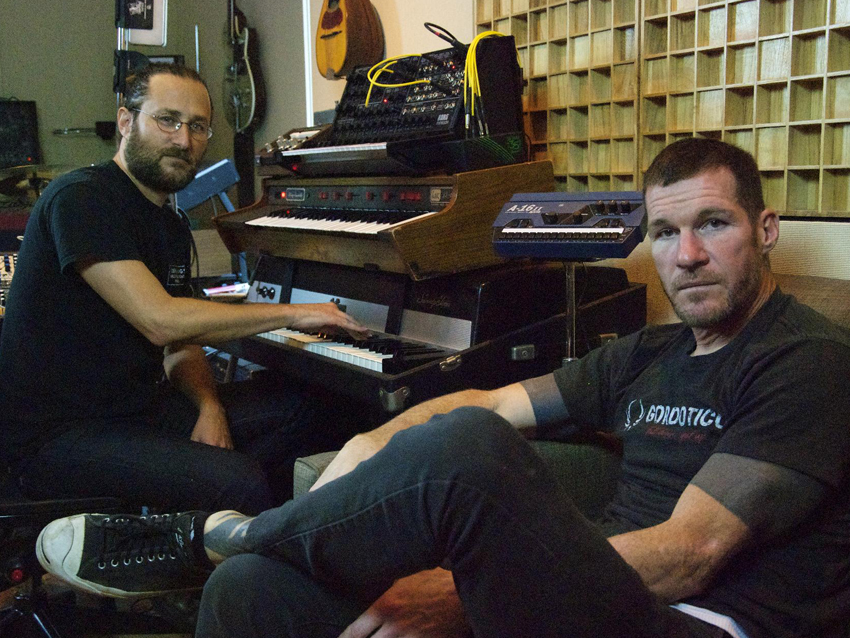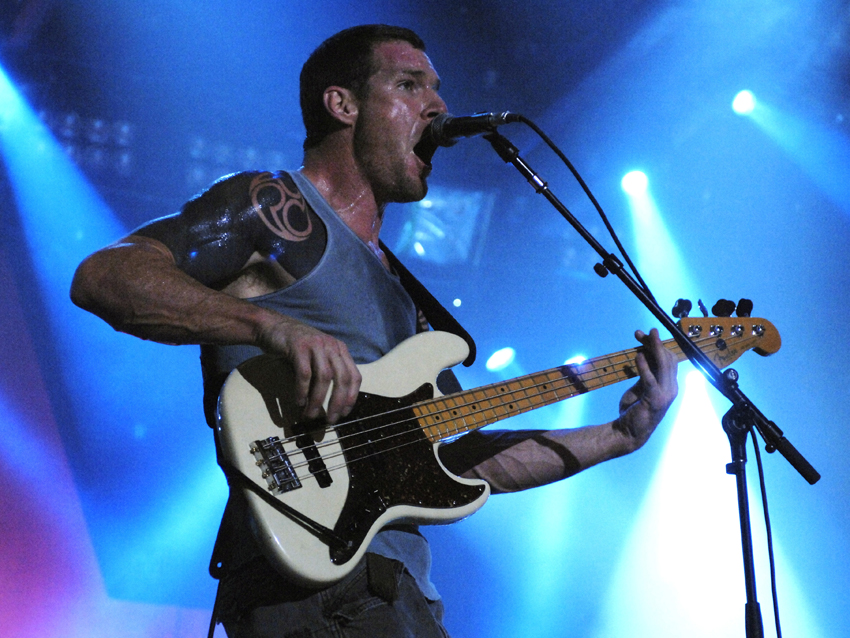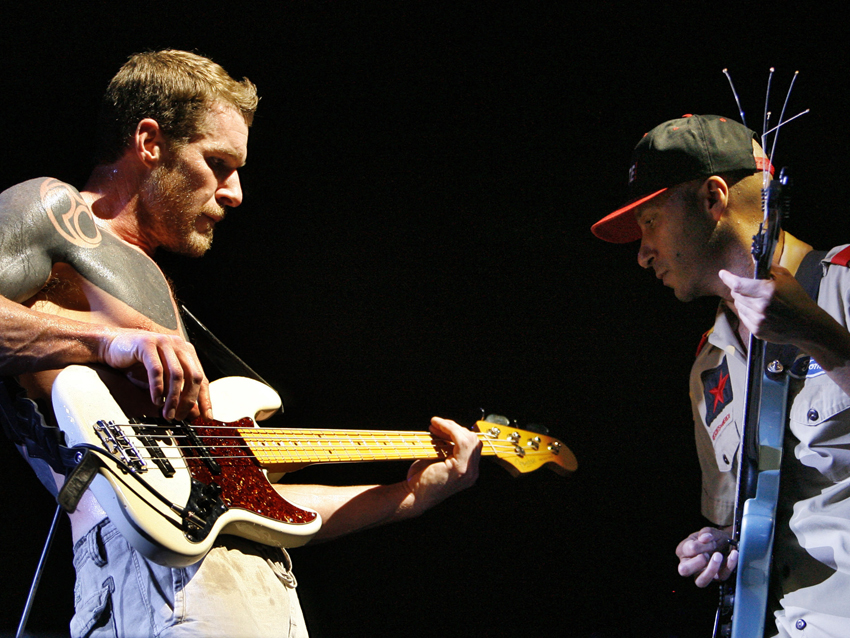
Tim Commerford talks electronic music and his new band, Future User
In the first few videos of his new band, Future User, bassist (and now lead vocalist) Tim Commerford appeared as a masked figure called S.W.I.M. (Someone Who Isn't Me). "I didn't want to trade on my previous bands, Rage Against The Machine and Audioslave," Commerford explains. "I wanted this to be more like I'm a regular guy in a band trying to make it in 2014 and 2015."
One look at the band's Clockwork clip (in which S.W.I.M. waterboards tennis legend John McEnroe) or the just-issued Mountain Lion video (in which Commerford, sans mask, sets himself on fire), however, and it becomes clear that the "regular guy" approach has its limits. "The videos we're doing are provocative, and I guess they're meant to be disturbing," Commerford allows. "I never wanted to make music or art that didn't really mean anything or didn't press people's buttons. That's never been my thing."
Future User differs radically from both Rage and Audioslave in that it's a heavily electronic-driven project – the band consists of Commerford and multi-instrumentalist Jordan Tarlow, and the only guitars heard on their debut album, #SteroidsOrHeroin, are courtesy of famed producer Brendan O'Brien, who has worked extensively with Commerford in the past.
Commerford sat down with MusicRadar recently to talk about his newfound love of electronic music, how he talked his good friend McEnroe into video torture, and whether Rage will be back in action anytime soon.
One big surprise is that you're Future User's lead singer. Did you always envision being the frontperson for the band?
“No, I didn’t. Not at all. I didn’t even know what this thing was going to be, really. Jordan is a super-talented engineer and producer with an amazing studio. We just got together and decided to make some music. We’d go on weird soundtrack loops, and we programmed drum patterns on Damage – that’s what we’d use as the catalyst for songs. But I wasn’t thinking of singing over it at the time; we were just in that state of creation.
“One day Jordan said that he’d seen an Audioslave clip when we played Letterman or Jay Leno. He loved my backing vocals and he said, ‘You should just try singing vocals on our stuff.’ I thought, ‘Why not? I’ll give it a shot.’ I went home, but I was back at his place within 45 minutes with lyrics and a vocal thing, ready to go.
“It’s very funny, actually: I’ve been in bands where I’ve had to wait a long, long time for lyrics and melodies; I know what that’s like. So I decided that I was gonna be as quick as I could be. I laid down my vocals in an hour. Even though I’m sort of used to the way my voice sounds, I wasn’t sure at first how it would work with the music. Jordan loved it, though, and that boosted my confidence. We kept knocking out songs, and there you go.”
Have you always been Mr. Electronic Guy, or is this a new thing for you?
“It is a new thing for me. I’m a fan of music, but I’m not set in any style. I came up on progressive rock. When I was a kid, before I played an instrument, I was into Kiss and whatever was on the radio – Foghat, straight-up rock bands. Then when I was in middle school, I got into punk rock and was obsessed with that. The Sex Pistols’ Never Mind The Bollocks was huge with me. I loved that record so much.
“I picked up the bass in seventh grade, and that’s when Zack [de la Rocha] and I started playing music together. He was a guitar player, and he and I played Sex Pistols songs. By the time I got to high school, I was into prog rock. Rush, Pink Floyd, Crimson, Genesis – I was Mr. Prog-Rock Guy.
“From there, I branched back into punk and hip-hop. But for the longest time, I was all about prog. I’m really thankful that I learned how to play Rush songs; I studied Geddy Lee big-time. To this day, I think his technique is perfect for what I did in Rage Against The Machine and everything else.”
A lot of people would call electronic music the new prog.
“Absolutely. That’s what I call it. Jordan has a digital studio that’s so high-tech. I consider the computer to be the ultimate prog-rock musician – it can do things that no human being can do. We’ve really embraced that. But Jordan’s also an analog synth freak, so we’ve got a Harp and Mini-Moog, Taurus pedals – sounds that we put into the computer. That’s totally prog. In fact, we call our music ‘progtronic.’”

On waterboarding John McEnroe on video
Above photo: Future User's Jordan Tarlow and Commerford
You decided that you needed some guitar, though, and you called up Brendan O’Brien.
“Yeah, that’s right. I love Brendan just as a person – he’s super-funny and great to be around. When I had some music that I had sung on that was starting to sound done, I called him to listen to it. I wanted his honest opinion. He said, ‘I like it. It’s cool, man!’ I asked him if he wanted to play guitar on it, and he was up for it. He’s an incredible guitar player. The guy has perfect pitch, and he can play you every Jimmy Page solo from front to back. Name a song and he’s got it note-perfect. Led Zeppelin, King Crimson, Yes – he can play it all. He’s a better guitar player than anybody knows, really.”
For a second, did you think to give Tom Morello a call, or did you think that the sound would be too close to Rage and Audioslave?
“Yeah, sure. I just wanted to do something different. Plus, when I went into this, I really wanted no guitar at all. I just wanted to computer to do everything. But the minute Brendan played on the stuff, it really worked and solidified the sound and the direction for what we’re doing.”
The role of video is already playing a big part in what you’re doing. A lot of bands don’t put so much stock in videos anymore.
“That’s true. I think coming up with the character S.W.I.M. has been such a cool thing for the videos. It kind of started when I went on these illicit drug forms, and there would be this person, S.W.I.M. – I’d have conversations with him. So I took that named and developed him into this character. S.W.I.M became the guy doing the waterboarding to John McEnroe in the Clockwork video.”
OK, so you’re friends with John, but how the heck do you talk him into being waterboarded?
“It wasn’t difficult, really. John and I have a relationship based around working out and cycling. I’m a huge cycling fan. Mountain biking, whatever – I ride my bike every day. So we go riding, and he’s definitely a solid rider, but like I said, I’m hardcore into it – every day. When we ride, I’m basically trying to put the hurt on him.
“All the time I’m really trying to hurt him. [Laughs] I take him to the stairs at Pepperdine University, and I make him do this incredibly hard workout I came up with – he’s just all sprawled out in pain at the end of it. Or I take him on these really long, hard rides where he’s just suffering. I torture him all the time. Doing this video, I just told him, ‘Dude, I’m gonna waterboard you,’ it was par for the course. I was like, ‘I’m gonna torture you some more.’ And that’s what happened.”
Warning: Video may disturb some viewers

On music with a message
What was his reaction to being waterboarded? How did he come through it?
“You know, it was intense. I researched everything, figured out how to build the table, built it to US specs; I strapped him on the table, and the only thing I did to help him out was give him a hammer. I told him, ‘OK, dude, if it gets too bad, if you can’t take it anymore, I want you to drop the hammer and I’ll stop.’ So we’re doing it, and at a certain point he dropped the hammer. But I kept going – for, like, 30 seconds longer.
“People who were in the room – the guys filming, and my manager was there – they were like, ‘Tim, stop! Stop!’ They were worried, but I kept doing it. When I finally let him get air, I would take the towel off his face. He’d take a big gulp of air, and then I’d dump more water down his throat – I barely gave him a second to recover. I really wanted it to be real. I wanted him to experience that Gitmo feeling. This went on for a couple of hours.
“Afterward, I bought a six-pack of beer and celebrated with him – ‘Cool, we made the video, man!’ I was all excited. It took a while for John to pull himself together. He went to the bathroom, and when he came back to the table he just put his head in his arms. I asked him if he was OK, and that’s when I saw he was crying. He was having a really hard time – he was shaking and really upset. He looked at me and said, ‘Dude, that was so out of control. No one should ever have to go through that.’
“And I was like, ‘Wow that’s awesome! That’s exactly what I wanted you to say. [Laughs] Now you can speak from experience about something that is totally fucked-up that we do as Americans that we should not be doing.'"
How do you respond to fans who want your music without the politics? I remember a few years ago even Paul Ryan said that he loved Rage’s music but not the lyrics. Tom Morello, of course, took him to task for that.
“You know, it’s exciting and it’s fulfilling to be able to incorporate a political view into music. It’s really cool and it’s a challenge to make something that has more than one dimension, and I’m so proud to be on that short list of bands that have something to say. There’s not a lot of them. The Clash, Public Enemy and a few more obscure bands like Midnight Oil – it’s a small group. I love being a part of that list. If people have a problem with it, that’s their problem. [Laughs] I just know that I’d be embarrassed to make music that has nothing to say.”

On Rage's future
Above photo: Commerford on stage with Rage Against The Machine's Tom Morello
What was it like setting yourself on fire in the Mountain Lion video?
“It was different… hot. [Laughs] I’m a thrill-seeker. I got set on fire, too, for the Supernatural video, but I had a full-body suit on. I’m good friends with one of the big Hollywood stunt coordinators, so he hooked me up with the fire guys. After the first video, I thought, ‘Well, I may as well go all the way.’ Wearing the suit, you almost don’t feel anything; you wait until you feel as though you’re gonna get burned, and then they put you out.
“For this video, without the suit, you get what they call a ‘skin burn.’ There’s only one guy in Hollywood who does a skin burn, and that’s who I worked with. They put this super-cold gel on you, everywhere fire might touch, and then they light you on fire.
“It’s a weird experience: You’re in the fire, you see the fire, and then you feel the fire. I’ve had a lot of injuries from biking, road rash and all that, so I didn’t think a skin burn could be that bad. You basically burn until you feel it burning you – it’s probably a second-degree burn. The guy who did it to me said that he’d never done it to anyone but a stunt man. That got me pretty psyched.”
Are you planning to play live with Future User?
“If there are opportunities, yeah; hopefully that’ll happen. I’ve gone to Coachella and have played there, so that would be cool. They have that tent where they play electronic music – the sound is insane! I remember driving away – I was probably 10 miles away from the festival – and I could still hear that electronic pitch banging.
“When we do play live, I want to tap into that super-low, super-gnarly sound. All of that music, be it Skrillex, Knife Party or Kill The Noise, it’s all in the key of G, which is the lowest note that a PA system can handle and still sound insane. It's the key of G and it's at 70 beats per minute. A lot of our music is right there; it’s patterned after dubstep but it’s not dubstep.”
What’s the status of Rage these days? You guys haven’t played a show since 2011.
“Our status is the same as it always was: You never know until you know. [Laughs] It’s like Batman waiting to see the Bat-Signal. Once in a while, the Rage light goes up in the sky, and we have to take care of business. It could be tomorrow; it could be 10 years from now. It’s not normally one person in the band putting that signal up; a lot of times it comes from outside the band. There could be a cause that’s important, so we’ll do a show, or it could be a place that we’ve never played, so we’ll be up for doing that. There’s no rules to how we operate.
“It’s a funny thing. We’ve been a band for over 20 years, and in that time I’ve seen other groups come and go. A band would come out of nowhere, sell 10 million records and just be huge. Two, three years later, where are they? No one knows who they are or remembers them. We never played those record company games – ‘You guys gotta keep making records, keep going on tour.’ We didn’t do any of that, and we’re probably bigger now than ever. If we made another record, it would be the biggest record we’ve ever made.”
Future User's #SteroidsOrHeroin will be released February 24. You can pre-order the album on iTunes.
Warning: Video may disturb some viewers
Joe is a freelance journalist who has, over the past few decades, interviewed hundreds of guitarists for Guitar World, Guitar Player, MusicRadar and Classic Rock. He is also a former editor of Guitar World, contributing writer for Guitar Aficionado and VP of A&R for Island Records. He’s an enthusiastic guitarist, but he’s nowhere near the likes of the people he interviews. Surprisingly, his skills are more suited to the drums. If you need a drummer for your Beatles tribute band, look him up.
